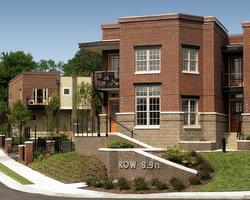Many inclusionary zoning ordinances include
density bonuses or other offsets to compensate land owners for the foregone revenue associated with inclusionary zoning requirements. Well-designed offsets help to facilitate political acceptance of inclusionary zoning policies, lessen the chances of successful legal challenges, and also reduce the likelihood that inclusionary zoning policies will create disincentives for new development, which could reduce the supply - and thus increase the price - of market-rate homes. Policies that are effective offsets may also be useful as incentives for voluntary inclusionary zoning policies.
The economics of development vary substantially from community to community and from housing type to housing type. It is thus important for jurisdictions to carefully consider what offsets are appropriate for their community, rather than simply borrowing policies that have been adopted elsewhere. Because for-profit developers are well-positioned to speak to market realities, and may be a political force affecting the chances of passage of an inclusionary zoning policy, it is important to include them in discussions around the design of appropriate offsets, along with affordable housing advocates and nonprofit developers. This process can
sometimes take a considerable amount of time and require serious
negotiation, but many communities have found this legwork to be
worthwhile in developing and building support for effective
inclusionary zoning policies.
| Solutions in Action
|
Finding Common Ground on Inclusionary Zoning -- In July 2005, the Non-Profit Housing Association of Northern California, an affordable housing advocacy group, and the Home Builders Association of Northern California, a building industry trade organization, jointly issued On Common Ground: Joint Principles on Inclusionary Housing Policies [PDF]. While the two groups have different perspectives and opinions on inclusionary zoning, this document represents an effort to find "common ground" and identify shared areas of agreement.
Recommendations in the policy brief include allowing market-rate builders to satisfy inclusionary requirements through land donation and off-site construction and making sure the local community is contributing to affordable housing production by offering density bonuses and providing dedicated staff to administer the inclusionary program.
|
You are currently reading:
Incentives and Cost Offsets
Mandatory inclusionary zoning policies frequently include provisions, such as density bonuses, designed to "offset" any foregone revenue associated with the inclusionary requirements. In a voluntary inclusionary zoning program, similar concessions are provided as incentives for participation.
Other pages in this section:
 Affordability Provisions Affordability Provisions
All inclusionary zoning policies contain basic components specifying when and how the policy is applied, including whether participation is mandatory or voluntary, the income level(s) targeted and the share of units that must be set aside as affordable.
 Other Considerations Other Considerations
Few housing policies have generated as much attention and controversy as inclusionary zoning. Beyond the basic mechanics of the ordinance, there are other key issues that communities thinking about inclusionary zoning should consider.
Click here to view more resources on inclusionary zoning.
|
Density bonusesOne of the most widely-used cost offsets included in inclusionary zoning policies, density bonuses allow more homes to be built on a parcel of land than would otherwise be permitted by the underlying
zoning code. For example, a 10 percent density bonus would allow 110 units of housing in an area originally zoned for 100 units. When offered in conjunction with inclusionary zoning, density bonuses can help developers recoup the reduced revenue associated with offering a share of units at below-market rates by increasing the number of units that may be sold at market rates.
It is important to note that density bonuses are only as valuable as developers' ability to overcome
NIMBY objections to higher density development and find a site able to accommodate the proposed new construction. Developers of density bonus programs should take into consideration the typical density of the community in which the bonus will be applied to ensure that new development will be marketable and compatible with existing homes. Relaxation of other land use regulations, such as those related to required
set-backs and lot size, may need to be applied in conjunction with the density bonus in order for its full benefits to be realized. In addition, public education and outreach can help to allay concerns about the appearance and impact of higher density development.
A common complaint among developers is that city planners or zoning officials refuse to allow them to build as many units as they are entitled to under the density bonus policy. To the extent these complaints are true, they would appear to undermine political support for inclusionary zoning and potentially reduce the number of market-rate units that get built, preventing the market from responding effectively to increased demand. Communities with inclusionary zoning policies should ensure that all city officials are on the same page in making offsets meaningful and achievable.
Click here to read a case study, prepared by Abt Associates for the National Association of Home Builders, describing the inclusionary zoning program in North Kingstown, Rhode Island.
In 2004, the Building Industry Association of Greater Los Angeles/Ventura County issued an alternative policy proposal in response to a proposed mandatory inclusionary zoning ordinance put forth by members of the Los Angeles City Council. Authors of the counterproposal, Housing For All: Fair Share Program [PDF], recommend the creation of Housing Incentive Zones throughout the City, within which developers would have the option to build at higher densities than ordinarily allowed, without the need to secure a rezoning or other special exception, in exchange for inclusion of a modest share of affordable units.
As suggested by this proposal, by combining greater density and affordability with the greater predictability afforded by as-of-right development, local jurisdictions may be able to design an inclusionary zoning policy that satisfies all stakeholders. |
Back to top
Flexible zoning and design standards
In addition to specifying allowable land uses and densities, zoning policies generally include regulations related to the placement of buildings on individual lots. For example, setback requirements dictate how far removed a structure must be from the street or neighboring lots; height restrictions limit the number of stories that may be built; and lot size specifications and floor-area ratios determine the overall allowable density.
Relaxation of these standards allows developers who participate in inclusionary zoning programs to reduce the costs of development associated with low-density, large-lot construction. Some communities go even farther and allow multifamily or attached housing to be built in districts zoned for single family homes as an offset for inclusionary zoning requirements. By increasing
the share of buildable land, flexible zoning and design standards may also be |

Photo credit: Affordable Housing Resources.
|
needed to help developers realize the full benefits of density bonuses.
Back to top
Reduced parking requirementsMany communities have parking requirements that establish a minimum number of off-street parking spaces that must be provided with each residential unit. As residential parking spaces can be costly to develop and occupy land that could otherwise accommodate additional homes, parking requirements may have the effect of increasing development costs and/or resulting in fewer homes built.
Particularly for developments with good access to public transit and other amenities or targeted on small households, the elderly and working families
[
1], local parking requirements may result in an overgenerous supply of parking. Some inclusionary zoning policies relax residential parking requirements for properties with an inclusionary set-aside, thus lowering development costs and freeing up land for the development of affordable homes.
Click here to leave this section and learn more about reduced parking requirements.
Back to top

Heart of the City, Burnsville MN -- Photo courtesy of LHB, Inc.
| Fee waivers or reductions
Many communities assess various types of fees on developers of new homes. These range from permit fees associated with new development applications to impact fees that cover the infrastructure associated with new units. These fees can quickly add up and substantially increase per-unit development costs. Some communities offer to eliminate or reduce various locally assessed fees on development that includes an affordable set-aside. Click here to leave this section and learn more about impact fees, one of the fees that can increase the cost of new homes.
|
Back to top
Local tax abatementSome inclusionary zoning policies offer to eliminate local property taxes for a specified period of time or grant other tax breaks to developers who include an affordable set-aside. By making these allowances, municipalities allow developers to reduce their ongoing operating costs and recoup some of the costs associated with delivery of below-market units.
Click here to leave this section and learn more about tax abatements.
Back to top
Expedited permitting and review processesIn some municipalities it can take months or even years to secure all the approvals needed to begin construction on a proposed development. While waiting for permits to come through, the soft costs associated with a property -- including property taxes and insurance payments, legal and other professional fees, and accrued interest -- can add up, eating away at the bottom line and making affordable homes more difficult to deliver. Some communities allow participants in inclusionary zoning programs to circumvent this lengthy process and access an expedited review and approvals track for the affordable units, or for the entire development.
Click here to leave this section and learn more about expedited permitting and review processes.
Back to top
Housing subsidiesA
study of inclusionary zoning [PDF] in California by the Nonprofit Housing Association of Northern California found that close to half of all jurisdictions with inclusionary zoning offer local housing funds to help subsidize inclusionary projects. Many of these jurisdictions are using these funds strategically to generate projects that exceed the minimum affordability requirement, lower the cost to the developer and help the jurisdiction get its money into housing more quickly.
Back to top[1] Studies have shown that car ownership is correlated with income level - as incomes rise, so does the number of cars a household is likely to own. See, for example, Parking Requirement Impacts on Housing Affordability [PDF]. 2006. By Todd Litman. Victoria, BC: Victoria Transport Policy Institute, p. 4.
